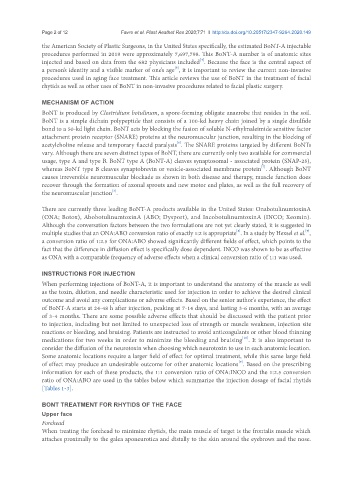Page 840 - Read Online
P. 840
Page 2 of 12 Favre et al. Plast Aesthet Res 2020;7:71 I http://dx.doi.org/10.20517/2347-9264.2020.149
the American Society of Plastic Surgeons, in the United States specifically, the estimated BoNT-A injectable
procedures performed in 2019 were approximately 7,697,798. This BoNT-A number is of anatomic sites
[4]
injected and based on data from the 682 physicians included . Because the face is the central aspect of
[5]
a person’s identity and a visible marker of one’s age , it is important to review the current non-invasive
procedures used in aging face treatment. This article reviews the use of BoNT in the treatment of facial
rhytids as well as other uses of BoNT in non-invasive procedures related to facial plastic surgery.
MECHANISM OF ACTION
BoNT is produced by Clostridium botulinum, a spore-forming obligate anaerobe that resides in the soil.
BoNT is a simple dichain polypeptide that consists of a 100-kd heavy chain joined by a single disulfide
bond to a 50-kd light chain. BoNT acts by blocking the fusion of soluble N-ethylmaleimide sensitive factor
attachment protein receptor (SNARE) proteins at the neuromuscular junction, resulting in the blocking of
[6]
acetylcholine release and temporary flaccid paralysis . The SNARE proteins targeted by different BoNTs
vary. Although there are seven distinct types of BoNT, there are currently only two available for commercial
usage, type A and type B. BoNT type A (BoNT-A) cleaves synaptosomal - associated protein (SNAP-25),
[7]
whereas BoNT type B cleaves synaptobrevin or vesicle-associated membrane protein . Although BoNT
causes irreversible neuromuscular blockade as shown in both disease and therapy, muscle function does
recover through the formation of axonal sprouts and new motor end plates, as well as the full recovery of
[3]
the neuromuscular junction .
There are currently three leading BoNT-A products available in the United States: OnabotulinumtoxinA
(ONA; Botox), AbobotulinumtoxinA (ABO; Dysport), and IncobotulinumtoxinA (INCO; Xeomin).
Although the conversation factors between the two formulations are not yet clearly stated, it is suggested in
[8]
[9]
multiple studies that an ONA:ABO conversion ratio of exactly 1:2 is appropriate . In a study by Hexsel et al. ,
a conversion ratio of 1:2.5 for ONA:ABO showed significantly different fields of effect, which points to the
fact that the difference in diffusion effect is specifically dose dependent. INCO was shown to be as effective
as ONA with a comparable frequency of adverse effects when a clinical conversion ratio of 1:1 was used.
INSTRUCTIONS FOR INJECTION
When performing injections of BoNT-A, it is important to understand the anatomy of the muscle as well
as the toxin, dilution, and needle characteristic used for injection in order to achieve the desired clinical
outcome and avoid any complications or adverse effects. Based on the senior author’s experience, the effect
of BoNT-A starts at 24-48 h after injection, peaking at 7-14 days, and lasting 3-6 months, with an average
of 3-4 months. There are some possible adverse effects that should be discussed with the patient prior
to injection, including but not limited to unexpected loss of strength or muscle weakness, injection site
reactions or bleeding, and bruising. Patients are instructed to avoid anticoagulants or other blood thinning
[10]
medications for two weeks in order to minimize the bleeding and bruising . It is also important to
consider the diffusion of the neurotoxin when choosing which neurotoxin to use in each anatomic location.
Some anatomic locations require a larger field of effect for optimal treatment, while this same large field
of effect may produce an undesirable outcome for other anatomic locations . Based on the prescribing
[9]
information for each of these products, the 1:1 conversion ratio of ONA:INCO and the 1:2.5 conversion
ratio of ONA:ABO are used in the tables below which summarize the injection dosage of facial rhytids
[Tables 1-3].
BONT TREATMENT FOR RHYTIDS OF THE FACE
Upper face
Forehead
When treating the forehead to minimize rhytids, the main muscle of target is the frontalis muscle which
attaches proximally to the galea aponeurotica and distally to the skin around the eyebrows and the nose.

